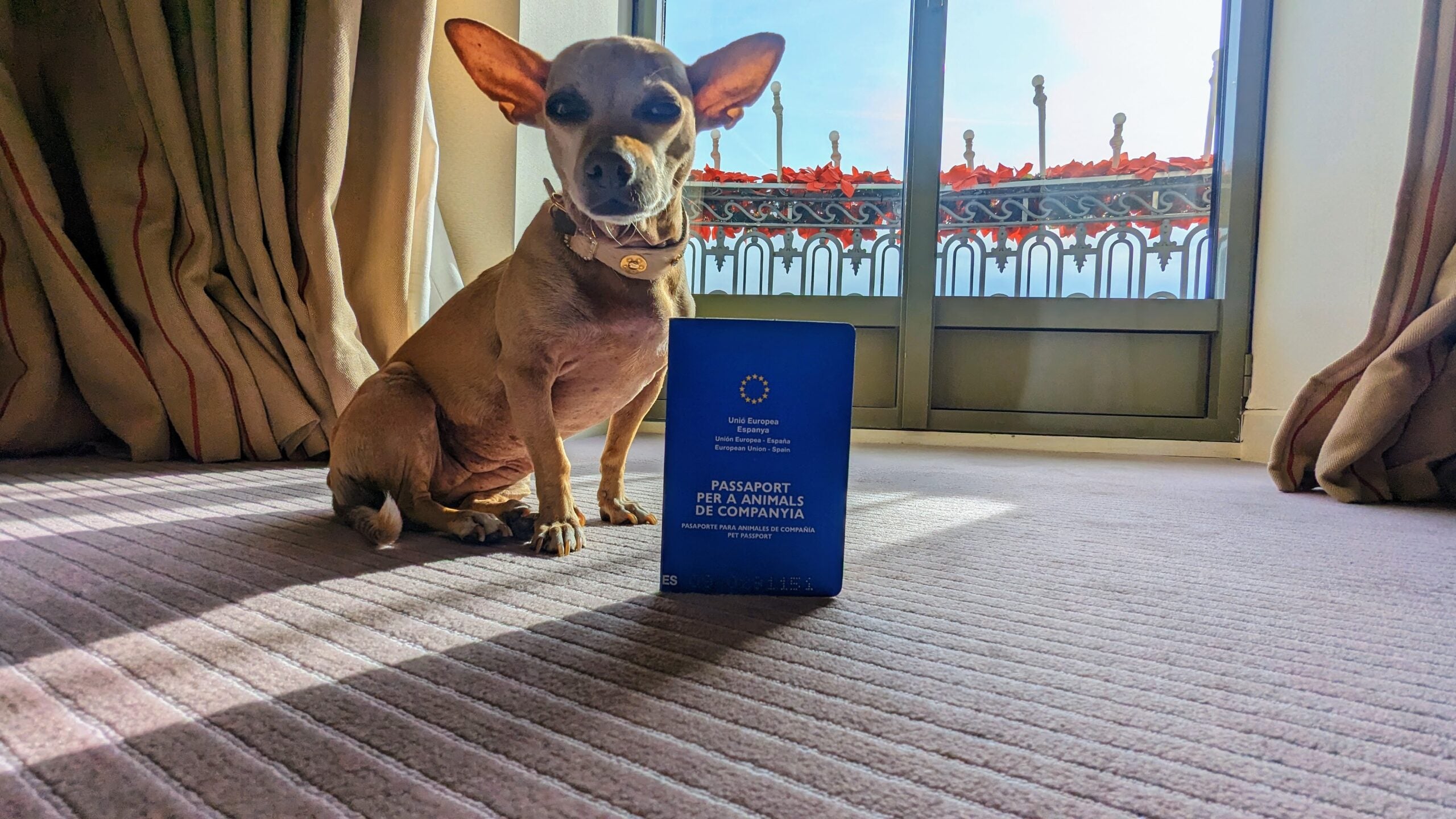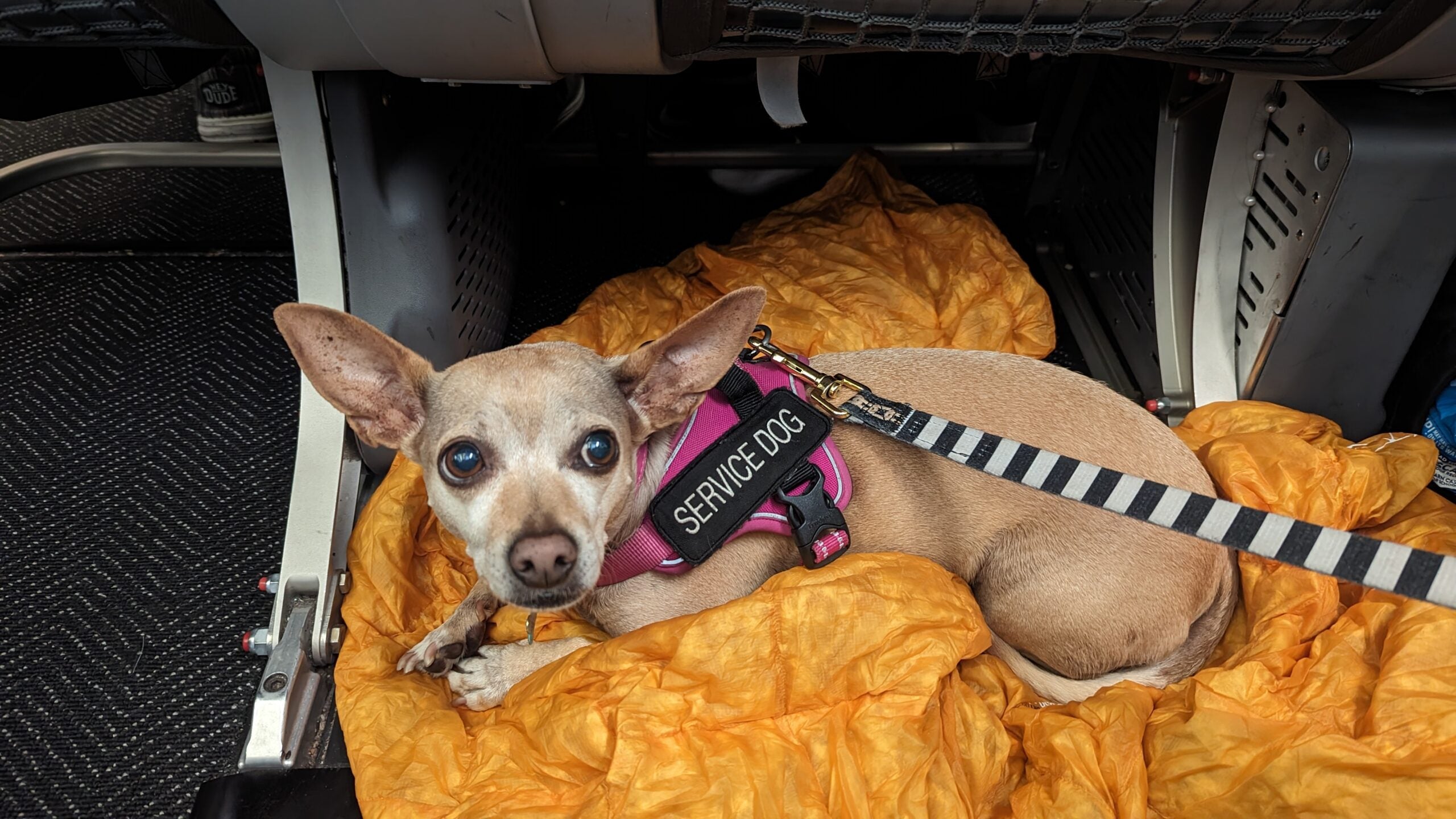Everything you need to know about traveling with pets to Europe
In 2023, my dog Poppy flew United Airlines 37 times, vacationed in Aruba and Mexico, and, most exciting of all, got her European Union pet passport in Barcelona.
Poppy, who is trained to assist me with a psychiatric disability, flies free as my service animal. However, we were spending a small fortune each year on international health certificates (around $300 per certificate) required each time an American dog enters any country other than Mexico and Canada.
Having an EU pet passport eliminates this step and allows Poppy to travel freely to EU countries — as well as Switzerland, Norway and much of the Balkans — for the next three years. This is a great cost-cutting measure for travelers who frequently visit Europe with a pet.
Getting an EU passport for Poppy in Spain was much easier than I expected. As I learned, Barcelona is the perfect destination to go through the process.
Pups are everywhere in this city, and it’s hard to walk for more than a minute without your doggo sharing sniffs with another canine. There are also fantastic dog-friendly hotels, restaurants, Europe’s only dog water park, beaches and even some attractions you can visit with your fur child.
Here’s everything you need to know about the EU pet passport process. Note this article pertains to American dogs traveling to and from the EU. Every country has different entry requirements. So, if your dog doesn’t live in the U.S., you’ll need to check with your home country about the requirements if you plan to travel back and forth.
What is an EU pet passport?
An EU Pet Passport is a document issued by an official veterinarian in a country within the EU that contains health information related to a specific pet. It cannot be obtained in the U.S. The passport is a blue booklet that resembles a human EU passport and even has space for a photo of your pup (though this is not mandatory).
What is mandatory is that your dog be revaccinated for rabies by the EU veterinarian that issues the passport. So, you must take your dog to Europe to get vaccinated. The trickiest part of this process is that your dog must be vaccinated against rabies twice if you are traveling to Europe and not moving there. This is because to return to the U.S., you will need a valid rabies certificate issued by an accredited American veterinarian. Think of it this way: A rabies vaccine basically serves as your pup’s passport, so they will be dual citizens.
“Luckily, there are no proven negative effects of double vaccinating a dog against rabies, so long as the vaccines are not given within a few months of each other,” Poppy’s veterinarian, Dr. Bethany Yurek, who practices in Colorado, told me. Poppy’s vaccines are spread out 1.5 years apart, which resulted from lucky timing, but if the vaccines are given about six months apart, you should be good to go.

Daily Newsletter
Reward your inbox with the TPG Daily newsletter
Join over 700,000 readers for breaking news, in-depth guides and exclusive deals from TPG’s experts
Of course, it is always best to consult your veterinarian before deciding to revaccinate before expiration. You will also want to request three-year rabies vaccines.
Why get an EU pet passport?
If you plan to travel to Europe multiple times over three years (the length of the longest rabies vaccine), an EU pet passport will save you thousands of dollars and a lot of time.
Without one, you will have to take your dog to its veterinarian to get an EU international health certificate issued and then endorsed by a vet at the U.S. Department of Agriculture. The entire process must be done within 10 days of entering the EU, and it’ll cost around $300.
You can use your health certificate to enter multiple EU countries for up to three months on a single visit, but you cannot use the health certificate for a second visit later. So, even though I got a health certificate when I took Poppy to Italy previously, it was not valid for this trip to Spain.
Obtaining an EU pet passport (besides being adorable looking) allows you to travel back and forth to EU countries, Switzerland, Norway and much of the Balkans without any other paperwork for as long as the EU-issued rabies vaccine is valid.
To maintain your dog’s EU passport, you must schedule their next rabies vaccine in Europe before it expires.
Can dogs living outside the EU get the pet passport?
Yes. “The purpose of the EU Pet Passport is to simplify travel between EU Member States, but the EU has also allowed it to be used for pets returning to the EU from other countries as long as it is a non-commercial movement,” according to the USDA. Noncommercial movement means you are not importing more than five animals to sell them. The passport is designed for pets only.
What is the process for getting an EU pet passport?
Getting an EU pet passport was a lot easier than I expected. I used TomVets in Barcelona; I found the company by quickly searching Google for vets with good reviews issuing EU pet passports to visitors. I reached out via WhatsApp and received a response in English within a day.
Dr. Tommaso Piermarini makes home vet visits. He came directly to the Majestic Hotel & Spa, where we were staying, to administer the rabies vaccine and issue the passport. It was so convenient that it immediately brought my stress levels down. I filled out some quick paperwork online before the visit, and that was it.
On the appointment day, Dr. Tommaso showed up promptly and spoke fluent English. We went to my room, and the process took less than 30 minutes. When he left, Poppy had a shiny new passport. The cost was also very reasonable at 155 euros ($167).
Barcelona is ideal for a Spanish citizenship vacation
Besides the ease of getting the EU pet passport here with a mobile veterinary service like TomVets, Barcelona is a fantastic doggy vacation destination. In addition to its Mediterranean climate, great food and beautiful beaches, the city welcomes pups with exuberance.
I stayed at the Majestic Hotel & Spa, an elegant neoclassical property on the city’s famous shopping street, Passeig de Gracia, in the trendy Eixample neighborhood. Welcoming guests since 1918, it’s the city’s most famed luxury hotel.
The Majestic welcomes small canine guests with its Very Important Pet package; the package includes a personalized welcome card, toys, treats, bottled water, a comfortable bed, food and water bowls to use during your stay. Dogs must weigh about 20 pounds or less — the same size pup that can travel as a pet in airplane cabins.
The hotel has various accommodation options, but in honor of Poppy’s Spanish citizenship milestone, we stayed in one of the Majestic Suites. The massive room featured multiple balconies offering jaw-dropping, panoramic city views; a separate bedroom and living space; a giant walk-in closet; and a marble bathroom.
Don’t skip sunset drinks and a bite to eat at the Majestic’s rooftop terrace bar — where you can, of course, bring your pup. The 360-degree views of the city serve as the perfect backdrop for a photo sesh with your best friend. The sunsets seem to go on forever with an everchanging display of vibrant colors.
The hotel also has a fantastic spa, and I got rid of my jet lag with a luxe two-hour body and facial treatment.
Dog-friendly attractions and restaurants
Across the street from the Majestic is Casa Batllo. Considered one of Spanish architect Antoni Gaudi’s greatest masterpieces, it was created in the early 1900s for a wealthy family. Nowadays, it is an immersive architectural museum experience and one of the few attractions of its kind that welcomes dogs. Poppy swapped tea with more than one canine visitor while I got lost in its trippy light shows, shimmering tile facade, undulating curves and other swirling shapes. If you visit during summer, Casa Batllo often has live music and drinks on its roof terrace.
The Majestic’s central location makes it easy to access some of Barcelona’s best neighborhoods for walking. The Gothic Quarter and the Born are within a 30-minute walk of the hotel. Most shops in Barcelona allow dogs, and many restaurants also welcome pets on their patios. Some places — like La Carioca, which serves Brazilian-inspired food and drinks — even include pups inside.
Related: 10 best dog-friendly destinations to explore this summer
Barcelona is also home to Europe’s first water park for dogs. AquaPark Canino is a must for pups who like to swim. The park, open from June through September, has two large swimming pools, a dune area for rolling, gardens for frisbee or ball-catching sessions, and even a restaurant where you and your pup can dine.
In winter, you can walk your dog along Barcelona’s beachfront and miles of gold sand. However, in summer, you’ll need to stick to Llevant Beach, Playa de Les Salines and Cala Vallcarca, which are dog-friendly.
The city also has several dog-friendly parks and gardens, including most parts of Park Guell, another Gaudi-designed masterpiece. Parc de la Ciutadella, Parc del Clot, Parc de la Barceloneta and Joan Miro Park also welcome woofers.
Finally, if your pup likes to shop, you must head to Barcelona Dogs in the Born. The shop carries one-of-a-kind designer collars and matching leashes as well as harnesses and coats for dogs and cats. Poppy chose a beautiful pink suede collar adorned with filigree crystals to celebrate her Spanish citizenship.
Related reading:











